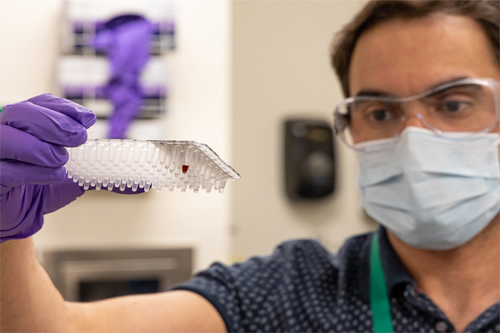
The original U.S. Department of Energy, Office of Science press release by Dr. Chris Fall, Director, Office of Science, can be read here.
Facing a global pandemic, the Department of Energy’s (DOE) national laboratories are mobilizing on a national scale in ways similar to their origins in the Manhattan Project. That sprawling R&D apparatus developed during WWII, which would become the starting point for today’s DOE national laboratory complex, was created to bring together our scientific and technical capabilities during a national crisis. Today, we’re calling on them again to answer the national need of combating the COVID-19 pandemic. With an extraordinary amount of bioscience and biotechnology expertise distributed across the seventeen DOE laboratories, but a need to focus our efforts against COVID-19 as one team, DOE and the laboratories have launched the National Virtual Biotechnology Laboratory (NVBL).
The NVBL brings together capabilities across the complex for tackling COVID-19 and creates a new front door for the broader research community to work with the laboratories on this challenge. Defeating COVID-19 requires conducting science at scale. With the facilities, expertise, and ability to coordinate them, conducting science at this scale is DOE’s superpower.
We’ve identified seven major areas where the national labs can provide unique contributions: molecular structure determination, computational modeling and simulation, epidemiological and logistics support, knowledge discovery infrastructure / scalable protected data, large-scale genomic science capabilities, testing of clinical and non-clinical samples, and supply chain bottlenecks. Let me share just a few of the many possible contributions NVBL can make.
The powerful X-rays at our light sources are one of the most common tools for determining the structure of the proteins that comprise SARS CoV-2, the virus that causes COVID-19. Figuring out these structures helps scientists understand where drugs can attach to the virus and disable it. Researchers used the Advanced Photon Source DOE Office of Science user facility to reveal the structure of a protein called Nsp15. This protein meddles with the human immune system. Developing an anti-viral drug targeting this protein could slow down the virus’s reproduction.
Cryogenic electron microscopy (cryo-EM) – microscopes that use electrons to probe the structure of very cold biological samples to near atomic resolution – are a powerful, complementary tool for determining the structure of viruses and their proteins. The 3D images this technique produces can also show how the virus interacts with antibodies and drugs. The Stanford-SLAC CryoEM Center at SLAC National Laboratory, supported by the National Institutes of Health, is running a suite of cryo-EM instruments to tackle these issues.
Our supercomputers are hard at work as well. Modeling and simulation are a specialty of our high-performance computing user facilities. They help scientists work through the many possible combinations of protein structures. They can also sort through combinations of existing drugs to search for possible treatments. We’re also using our computers to model the spread of diseases and analyze health care data. Our supercomputers are particularly good at handling the many variables in epidemiological models, from traffic patterns to differences in populations.
While most people don’t associate DOE with genomics, we have vast experience analyzing and sequencing genetic data. In particular, we know a lot about analyzing microbial genes, including viruses. The high-throughput genomic sequencing and data analysis capabilities at our Joint Genome Institute user facility and the advanced proteomics and other characterization tools at our Environmental Molecular Science Laboratory user facility, along with powerful capabilities at several other DOE laboratories, can help scientists identify parts of the viral genome that are stable over time. Those are the sections doctors could target with vaccines or anti-viral drugs.
Manufacturing technology is another area where DOE is shifting its skill toward addressing COVID-19. Our additive manufacturing (3D printing) facilities customarily work to make manufacturing more energy efficient. But now we’re using them to break the bottlenecks in health care equipment manufacturing. Although our national labs will not be making surgical masks or ventilators, they can use their expertise to create molds and dies for better parts that are faster to manufacture.
The NVBL is a model for the future, helping us to increase coordination across our laboratories and leverage unique proficiencies and tools for common national needs. For decades, DOE has wrestled with the biggest challenges in science, from high energy physics to genomics. In this time of need, we’re proud to unite our national laboratories in service to our country and the world.
The Office of Science is the single largest supporter of basic research in the physical sciences in the United States and is working to address some of the most pressing challenges of our time. For more information please visit https://www.energy.gov/science
The U.S. Department of Energy's Advanced Photon Source is one of the world’s most productive x-ray light source facilities. Each year, the APS provides high-brightness x-ray beams to a diverse community of more than 5,000 researchers in materials science, chemistry, condensed matter physics, the life and environmental sciences, and applied research. Researchers using the APS produce over 2,000 publications each year detailing impactful discoveries, and solve more vital biological protein structures than users of any other x-ray light source research facility. APS x-rays are ideally suited for explorations of materials and biological structures; elemental distribution; chemical, magnetic, electronic states; and a wide range of technologically important engineering systems from batteries to fuel injector sprays, all of which are the foundations of our nation’s economic, technological, and physical well-being.
Argonne National Laboratory seeks solutions to pressing national problems in science and technology. The nation's first national laboratory, Argonne conducts leading-edge basic and applied scientific research in virtually every scientific discipline. Argonne researchers work closely with researchers from hundreds of companies, universities, and federal, state and municipal agencies to help them solve their specific problems, advance America's scientific leadership and prepare the nation for a better future. With employees from more than 60 nations, Argonne is managed by UChicago Argonne, LLC, for the U.S. DOE Office of Science.
